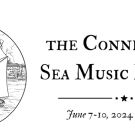June 2024
“Born to Build: Cape Dory . . . A Standard of Value”
by Andrew C. Vavolotis and James L. Nelson. ACV Boatworks, LLC, Publisher. 217 pps. $44.95.
Review by Bob Muggleston
S ailors in New England are well familiar with the many Cape Dory offerings that still, some 30 years after the company’s demise, inhabit our harbors. Many of them are designer Carl Alberg’s take on the classic Swedish Folkboat that feature long, graceful overhangs, low sheerlines, narrow beam and sweeping full keels. These boats were pretty then and even prettier now in this era of function over form, and remain eminently seaworthy. Vlogger Sam Holmes of YouTube fame is currently crossing oceans on a modified CD 28, and other less-famous sailors are making similar journeys on even smaller Cape Dory-built boats.
ailors in New England are well familiar with the many Cape Dory offerings that still, some 30 years after the company’s demise, inhabit our harbors. Many of them are designer Carl Alberg’s take on the classic Swedish Folkboat that feature long, graceful overhangs, low sheerlines, narrow beam and sweeping full keels. These boats were pretty then and even prettier now in this era of function over form, and remain eminently seaworthy. Vlogger Sam Holmes of YouTube fame is currently crossing oceans on a modified CD 28, and other less-famous sailors are making similar journeys on even smaller Cape Dory-built boats.
While well aware of Alberg’s association with Cape Dory, as well as his relationship with Pearson and Bristol, I never knew anything about Andrew Vavolotis, the founder of Cape Dory. In some ways he’s a more fascinating character than Alberg himself, who, despite being a personal hero of mine, was more or less scaling up or down the same wonderful hull shape and essentially had no skin in the game once a design left his desk. Vavolotis started Cape Dory in 1963 in Bridgewater, Mass., where he built 10-foot dinghies in a garage. By 1984, at his 142,000-square-foot factory in East Taunton, Mass., he employed 325 highly skilled workers, had founded Spartan Marine to churn out hardware for the hundreds of boats he was building, and had purchased Robinhood Marine, in Maine, as a place to test a commercial line of boats. For all intents and purposes, it looked like Cape Dory Yachts was an unstoppable machine.
Those of us actively sailing at the time experienced first-hand what would happen: The sailboat market fell off a cliff in 1985. In an effort to stay alive, Vavolitis significantly scaled back his sailboat-building operation to focus on trawlers. Cape Dory made some wonderful trawlers in the next few years, but in 1990 the luxury tax, which added 10% to the cost of recreational boats costing above $100,000, essentially drove a stake through the company’s heart. A sad ending to a wonderful company that had already survived two oil shortages, but a story familiar to many other boatbuilders at the time.
What a treasure this book is for fans of boats built during the golden age of American fiberglass sailboat-building. “Born to Build” is written with Vavolitis as the narrator, and is loaded with supporting photos, designs and anecdotes from various staff members. Do you have a favorite Cape Dory sailboat or powerboat? The idea of that boat, its design, and the specifics of its build is faithfully recorded in “Born to Build.” And Vavolotis need not fret: The legacy of his company will continue as long as fiberglass-built boats remain viable, which might be just short of forever.











